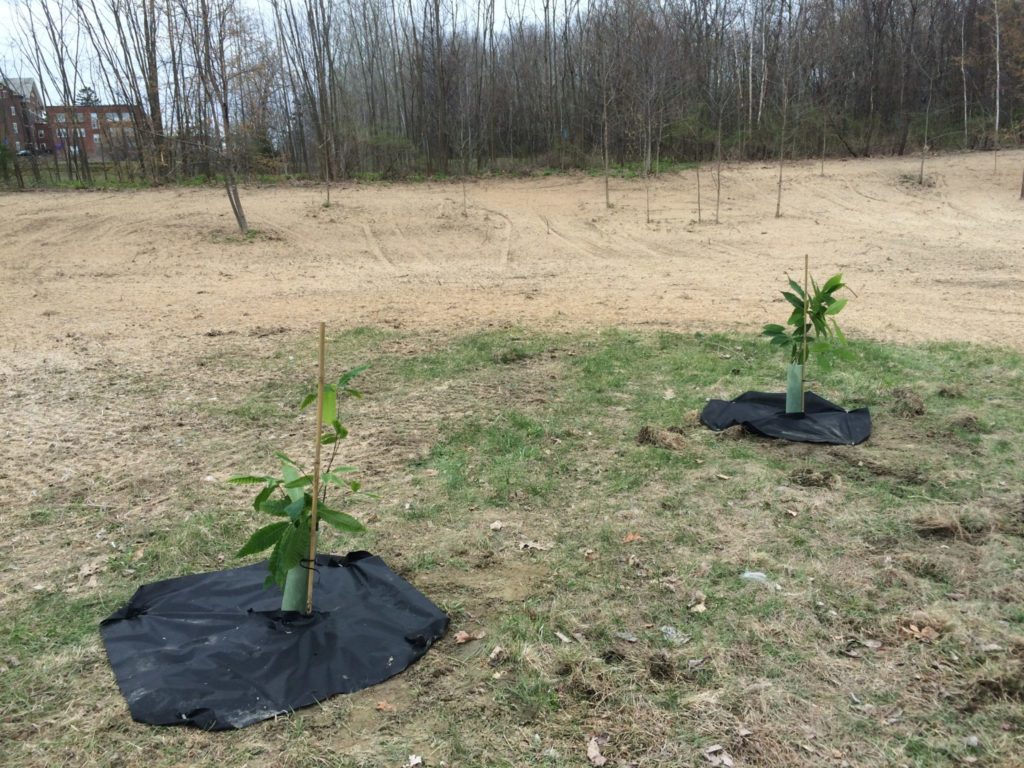Reforestation for Climate Action

By: Hannah Phillips
Big changes are about to start appearing on the former Burlington College land at 311 North Avenue. Yet, as preparation is underway for conversion into a new housing complex, less obvious changes are already visible on the fringes of this landscape. Student groups and city employees are planting tree seedlings to convert these field edges back into forest.
Walk down the dirt path linking North Avenue to the Bike Path, through the black locust forest, and look right as you enter the field. Here, blue tubing is scattered amongst waist-high vegetation, the tubes encasing tree saplings to protect them from herbivory by deer and rodents. These are the first trees among thousands planted in three sites around the city as part of an effort to reach 50% tree cover by 2025, one step towards reducing the city’s carbon footprint.
But getting from 43% urban tree canopy cover – where we are now – to 50% by 2025 is an ambitious goal. According to Warren Spinner, City Arborist, most cities of our size around the country hover at around 20-25% canopy cover. Though Burlington is already far ahead of the average, increasing the urban tree canopy is one step towards achieving the city’s Climate Action Plan[1]. To stay on track with this goal, the city will need to plant 600 trees every year until 2025. While some of these plantings happen on private land, in backyards and outside businesses, planting on city-owned land will account for a large percentage of the effort.

But, practically speaking, where in Burlington does one put 12,000 trees? City Field Naturalist Alicia Daniel and City Land Steward Dan Cahill together identified publicly-owned sites that were once forested, are now cleared, no longer need to remain open, and are ecologically unique. These sites – in Oakledge Park, McKenzie Park, and at 311 North Avenue – have the potential to host hardwood swamps, floodplain forests, and a sandplain forest, respectively. Through Daniel and Cahill’s eyes, reforestation in these cases would not only mean increased carbon sequestration; restoration could also mean the return of uncommon plant communities and the suite of benefits they provide for humans and wildlife alike.
Yet, turning a field back to forest is not quite as straightforward as it sounds. Invasive plants, herbivory, and altered site conditions all threaten to derail the best-laid plans. Few people know this better than Dr. Bill Keeton, Professor of Forest Ecology and Forestry at UVM and a collaborator on the project. “I always expect to lose about 50% of what I plant in the first three years, especially when you’re working with relatively small, bare-root planting stock, which is what we have. Those are prone to a lot of stress.” For this reason, restoration efforts require a healthy dose of patience and a willingness to adapt.
The task of restoring natural communities on disturbed sites was a perfect challenge for Keeton’s students in UVM’s Restoration Ecology class. The students, primarily junior Environmental Studies majors, took a lead role in designing a restoration plan for the North Avenue site. In addition to reintroducing the original tree species, they planted shadbush and witchhazel in the understory to produce mast for wildlife, and installed revetments in a sandy ravine (constructed from coarse woody debris collected on site) to stabilize eroding banks with “soft engineering.” Guided by the native vegetation of the original natural community (once a “Pine-Oak-Heath Sandplain Forest”), they planted a variety of species that would have originally thrived on the sandy bluff – including oaks, black cherry, white pine, and pitch pine – in the understory of the thinned forest.

Seedlings for the project came from nurseries throughout Burlington. Intervale Conservation Nursery and Branch Out Burlington provided common native species, some of which were borne from seeds collected locally. In other words, the trees now growing on the restored Burlington College site may be the offspring of the trees that stood on this sandy bluff long ago. The most novel contribution to the project, though, is 2000 hybrid blight-resistant American chestnut seedings, which were donated to the project by the American Chestnut Foundation.
The long-term success of restoration efforts at the three sites will depend upon ongoing monitoring and adaptive management. According to Keeton, “we’re expecting the city will need to come back, or maybe the class will come back, and we’ll need to do some supplemental planting. That might have to happen iteratively over the next 10-15 years until we really get what we want established out there.” This duty will continue to fall to city staff, although Cahill explains the inherent educational value of these projects makes them great opportunities for collaboration with local schools, colleges, and universities.
Now that almost one year has passed since the seedlings were planted at the North Avenue site, how are they doing? Cahill attests that at the end of year, one, they have lost 20% of the 700 trees planted at North Avenue. Daniel has plans to work with the first-year field ecology course in UVM’s Rubenstein School of Environment and Natural Resources to inventory mortality at Oakledge and MacKenzie Park later this fall. These initial inventories will help Daniel and Cahill decide what management steps are needed to help the remaining seedlings thrive.

Ultimately, though, these sites are just a fraction of the trees that the City hopes to plant by 2025. If you are interested in helping the city reach its goal of 50% canopy cover by 2025, consider purchasing a tree at the Intervale Conservation Nursery or Branch Out Burlington. One more city tree will offer shade for passersby, a seasonal burst of color, and will help us all breath a little easier.
[1] https://www.burlingtonvt.gov/sites/default/files/CEDO/Sustainability/Climate%20Action%20Plan.pdf
